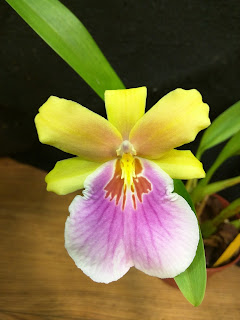There aren't many orchids that give you a colour combination like that. I will admit straight away that I have not long repotted this plant and it is somewhat having a fit of pique and so has sulkishly only produced one flower for me on this occasion.
So, maybe I should compare Miltonia and Miltoniopsis. Firstly, they come from different countries. I think I've discussed that bit in a previous post, so I shan't do it again. Vegetatively, I have never thought there was much similarity between the two genera. Miltonia have fresh, almost yellowish green leaves (when grown under correct light levels), quite pronounced rather tall pseudobulbs and generally a short (or long) length of rhizome separating the pseudobulbs. In contrast, Miltoniopsis have greyish green, thin foliage that envelops the rather small, laterally flattened pseudobulb in a fan, and generally produce clumps of foliage without much visible rhizome. The foliage grows in a folded concertina fashion if you so much as look askance at it, which is apparently due to lack of humidity but is more likely due to root damage inflicted before purchase. The flowers of some species and a couple of hybrids of Miltonia look superficially like Miltoniopsis (as does the one above), but there are no strong yellows among Miltoniopsis (one species is a pale yellow but this doesn't seem to come down the breeding line very strongly, so the yellows are always rather wishy-washy (sorry.....pastel)). As you can see above, Miltonia are rather good at yellow, as they are at mixing and matching their colours in odd and entertaining ways. There is something about Miltonia sunset that screams either cocktail or rhubarb and custard at me. On this hybrid, there are usually around five flowers on a spike, usually one spike per pseudobulb (Miltoniopsis, when well grown, are quite capable of producing two or more spikes per pseudobulb).
One thing I have noticed about all the Miltonia I grow is that they tend to be rather shallow rooted, so there is no point in putting them in a regular shaped pot and expecting them to fill it. Shallow pots are definitely better. Roots are fine, even finer than Miltoniopsis, and they prefer a medium or even fine bark substrate, provided it drains well. They seem adaptable to temperature, too. I grow mine warm, but I know of people who grow them cooler than me with equally good results. Pests seem mercifully non-existent on them too, a real bonus. My ever-blighted attempts to grow Miltoniopsis (I do like the flowers) have always become a spider mite infested mess and have ended up in the bin.
I have a friend who grows a Miltonia sunset that doesn't seem to produce the long rhizomes like mine does and stays all well-behaved and clumpy in its pot. I'm not sure whether I'm jealous or not, as my plant (actually I have two) behave more like teenages and keep climbing out of their pots. I'd love to know why they behave so differently. The one photographed as just been potted down a bit and had its backbulbs removed. A mistake, I fancy. The other plant is now so far over the edge of the pot it won't stand up, but it does flower nicely. It is in spike as I write. Once it has bloomed, I'll try to decide what to do with it. I might even write a blog post about it, who can say?


No comments:
Post a Comment